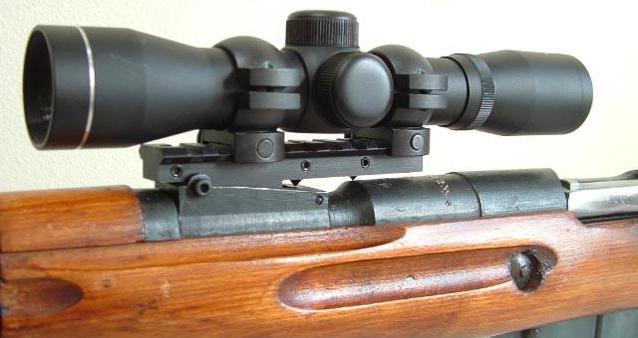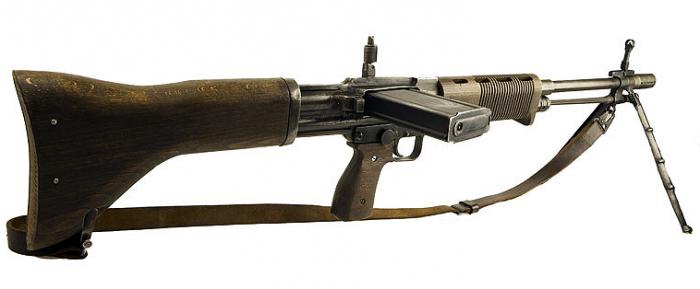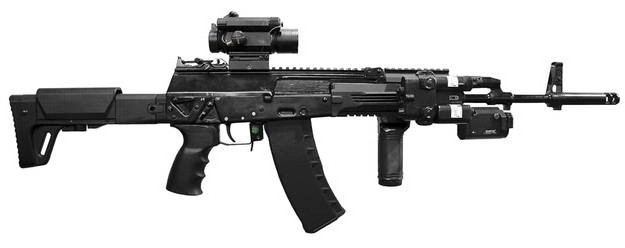Rifles of the Second World War. Weapon. Three-line Mosin
It is generally accepted, with the light hand of the Soviethistorians that the German fascist hordes that attacked the USSR in 1941 were completely armed with submachine guns, which almost every soldier of the Wehrmacht almost continuously scribbled from his Schmeisser. As it turned out in the last two decades, after an objective study of the facts, this was not quite so. Firstly, the German automaton was called, depending on the modification, MP.38 or MP.40, and secondly, the designer H. Schmeiser did not develop it, but introduced a number of changes (including a wooden butt) into his design, creating quick-firing assault rifle, which received his name, and it was later. And thirdly, the main weapon of the Nazi invaders during the entire war was a rather powerful Mauser rifle Gewehr-98. If you carefully read the chronicles of the invasion period, you can see it, like the horse carts that made up the main transport of the Germans. The situation in the Red Army was about the same. The three-line Mosin, whose canvas belt was mentioned by the poet Tvardovsky, served the Homeland for a good half-century with faith and truth.

Mauser Rifle: Prototype and Development
Hitler was a conservative. He went through the First World War, and although some of his biographers hint at the rather curious circumstances of receiving the Iron Cross, the future "Fuhrer of the German people" still had to be fought. He did not trust very fast compact weapons and considered Mauser the best designer in the world, who managed to create an unsurpassed model. Therefore, the German rifles of the Second World War were almost the same as those fought by the soldiers of Germany and Austria-Hungary in 1914-1918, with minor constructive changes. Its prototype was Gew.71, developed by the brothers Wilhelm and Peter-Paul Mauser, as is clear from the index, in 1871. Then came new, improved samples ("88", "89", "92" and "94"), taking into account the proposals for improving the performance coming from the military. Ultimately, all these changes are reflected in the final "Mauser" 71 years. These were the most massive German rifles of the Second World War.

The history of the Mosin trilinear
Stalin thought more progressively, which gave hisresults. Machine guns in the USSR were produced 6 times more than in fascist Germany (six million against one). But this does not mean that traditional small arms were not paid attention. The development of new samples was underway, they were tested in combat conditions (and there were enough of them: Khalkhin-Gol, Karelian Isthmus), advantages and disadvantages were determined. But, strangely enough, the best weapon of the Red Army was the three-line Mosin, created under the tsar. It was reliable, easy to manufacture, and was distinguished by a happy combination of excellent tactical and technical data with ease of handling.
She has her own story, rooted insixties of the century before last. Then the Russian army needed a new small arms, and this problem was first dealt haphazardly. Then, in 1892, a competition was announced, in which many firms, including Austrian Manlicher, Danish Krag-Jorgensen and the Belgian Nagan, willingly took part in the search for profitable and large orders. Did not stay aside and the Russian gunsmith SI Mosin. Ultimately, the domestic model won, although in its design the author had to make a number of changes, borrowing them from competitors.

German Mauser carbine
Design idea of gunsmiths of the late XIX centuryworked in about the same direction. Overview of the rifle Gew.98 will not reveal special revolutionary boldness. Unless the circuit of the lever fuse is novel, and the five-cartridge store is compact in size due to the two-row arrangement of ammunition. By the way, the capacity of the clip was proposed to be increased to seven or even ten charges, but the German General Staff decided it was quite five. Brothers Brotherhood Mausers created their own, taking care of the sale of "supplies", and, moreover, improved their characteristics (its size is 7.92 x 57). The sight is planned, with a range of up to 2 km. And, of course, a bayonet in the form of a cleaver, although other types were also offered.
As for the name "carbine", it practically did not change anything, except the method of fastening the belt.

Mosin's construction
The design characteristic of the Mosin rifle inthe whole differs little from the description of the German analogue. The caliber of three lines (0.3 ") was the Russian standard, the trunk is long (more than a hundred calibers). The shop is box-shaped, its capacity is four rounds. Recharge is carried out manually, the slide is longitudinal-sliding type. The fuse is very simple and in Russian original: to avoid an accidental shot, you should pull the trigger and slightly rotate it around the axis, after which the fighter could no longer hit the cap. The sight had a somewhat greater accuracy of graduation due to its two possible positions. The step of each scale is 200 meters.
Special words deserved bayonet, which wereequipped with Soviet rifles of World War II. It was tetrahedral with a flat point (it could be used as a disassembly tool). He was terrible: the edges of the wound inflicted on him, immediately converged, and internal hemorrhage occurred. The Russian faceted bayonet was later banned by international conventions.
After 1939, the troops receivedModernized Mosin rifles, which differed from the prototype by some features of the design, however, insignificant. Lodgment rings, ways of fixing the bayonet and ramrod have changed, and the calibration of the sight was made metric.
In other countries
Not only in the two main belligerent countries, but also into the rest of the world, the attitude toward automatic types (at that time mainly to the submachine guns) was cautious. Re-armament required a huge investment of funds, and no one could predict the result. Accuracy of hitting and reliability of new samples raised doubts, development and testing required an increase in defense budgets. In addition, it was clear to everyone that the considerable load carried by the soldier would become even greater, since you would not get ammo on all these machines. The most massive rifles of World War II were produced in the USA (Springfield and Garand), Britain (Le Enfield), Italy (Mk I No. 4) and Japan (Arisaka), except the USSR and Germany, . All of them had shortcomings and dignities, but in general they proved to be quite equivalent. And the main rivals were Soviet and German gunsmiths.

Automatic АВС-36
With rifles, these rifles are called because the trunkthey have a thread that creates a rotational moment to the bullet, which as a result has a smaller deviation from the target. The weapons are in all respects good, but the massive samples, both of the Red Army and of the Wehrmacht, had a significant drawback - a low rate of fire. After the shot, the fighter had to shake the bolt to send another charge to the chamber, and this took precious time. The 7.62 Simonov rifle of caliber 7,62, adopted in service in 1936, had a more complicated construction than the three-lane, it had a self-cocking gun operating on the energy of propellant gases. In addition, the muzzle brake, reducing the impact, increased the accuracy of hits. However, with all these advantages, the excessive consumption of ammunition worsened the combat capabilities of the weapon, and the magazine for 15 rounds increased the weight. The command was inclined to the opinion of the expediency of replacing the ABC-36 with a more perfect sample.

Tokarev self-loading system SVT-38
The Tokarev SVT-38 design complied withconcept more self-loading than an automatic rifle. Compared with the ABC-36, it favorably differed in its aiming range, improved convenience of service, but, unfortunately, it was too cumbersome and capricious. Especially these shortcomings were manifested during the Winter War, when refusals became frequent in conditions of low temperatures. Nevertheless, despite the fact that the sample was withdrawn from production in 1940, the Tokarev SVT-38 served in the years of the struggle against the fascist invasion. They were used mainly when accuracy was more important than reliability.
The following construction of Tokarev SVT-40
The flaws in the design of SVT-38 were partially eliminatedin the following 1940 model. With bulky and overweight designers struggled by drilling holes and deepening chamfers wherever it was possible. SVT-40 became even lighter than three-line, but was inferior to it in the main quality, the most appreciated by soldiers - in reliability. In addition, the poor technical training of the personnel of the greater part of the Red Army prevented the competent servicing of this rather complex weapon. Heap also limped. But its use SVT-40 found in special units designed for accurate fire. From it turned out to be not the best sniper rifle, but quite decent. Each "trunk" has its own character and character, and if the shooter was talented, he soon got used to his weapons, adjusted to him and achieved excellent results.
Semi-automatic AVT-40
Production of the machine was more expensive thanrifles. Before the war and at its beginning, this was of great importance, so Tokarev created something average and seemed to be optimal. A soldier armed with an AVT-40 rifle could fire single shots and bursts. The store housed ten cartridges. However, it soon became clear that the receiver was not able to withstand sustained shock loads, and shooting in automatic mode was banned. The main advantage of the sample turned out to be useless, and for all other indicators the sample was inferior to the rifle of the Mosin system.

Weapons of Soviet snipers ...
There is a category of small arms, when developingwhich all the usual characteristics of mass samples are receding into the background. The main goal of the designer is to ensure the ability of the shooter to get from a long distance exactly to the target. Accuracy is most important. Soviet sniper rifles of the Second World War were produced in two main systems. In 1931, the same Mosinskaya three-line, with a slightly modified shutter handle, and executed with a special qualification, received an optical sight. Externally, it differed from the original design in that the stem of its shutter was directed downward, and not upward, as in the prototype.
Soviet sniper rifles of the SecondWorld War SVT-40 described above. It only remains to add that during their manufacture, the greatest precision of metal working was shown, and, of course, the bracket for optics was designed in a constructive way.

... and German
At the beginning of the war, the advancing fascists succeededgrab a significant stock of Soviet weapons. They did not fail to take advantage of them. As a result, many Soviet rifles of the Second World War, including sniper rifles, went into service with the Wehrmacht. For all the simplicity of the design, they were highly appreciated by the enemy, who until 1942 had not the most perfect samples at his disposal. These include sniper rifles Zf.Kar.98k, representing a somewhat improved "Mauser" in 1898, and some trophy units captured in previously occupied countries (Czechoslovakia, France, Belgium, etc.). Very curious is the attempt to create a kind of hybrid machine gun and sniper weapons. The design was called Fallschirmjägergewehr 42 (rifle for the parachutist). Some experts even tend to believe that this was the best sniper rifle. In any case, at that time it was the most modern development and came only to the elite units of the paratroopers and the SS.
After the war
Currently, worldwide automaticSmall arms dislodged rifles. Now they shoot only snipers. The most widespread special weapon in the entire post-Soviet space and far beyond its borders today is the Dragunov Rifle, developed in 1963. The reason for its popularity is characteristic of all Russian weapons. It is unpretentious, reliable, relatively inexpensive and has excellent characteristics. The SVD design combines all the best qualities that sniper rifles of the Second World War, especially Soviet ones, possessed. Many of the design solutions invented or improved in the 30s and 40s have found application in its design.

Comparison with the American analog M24, at the firstview, convinces the superiority of the American model. A high level of accuracy was achieved by overseas engineers, applying a step of cuts of 320 mm. However, in actual fact it turns out that, unlike him, the Dragunov rifle is universal and can fire all types of ammunition, including armor-piercing and incendiary. During the time of operation, there have been cases when even aerial vehicles could be brought down from the SVD, including such complex ones as the UAV, helicopters and jet attack aircraft.








